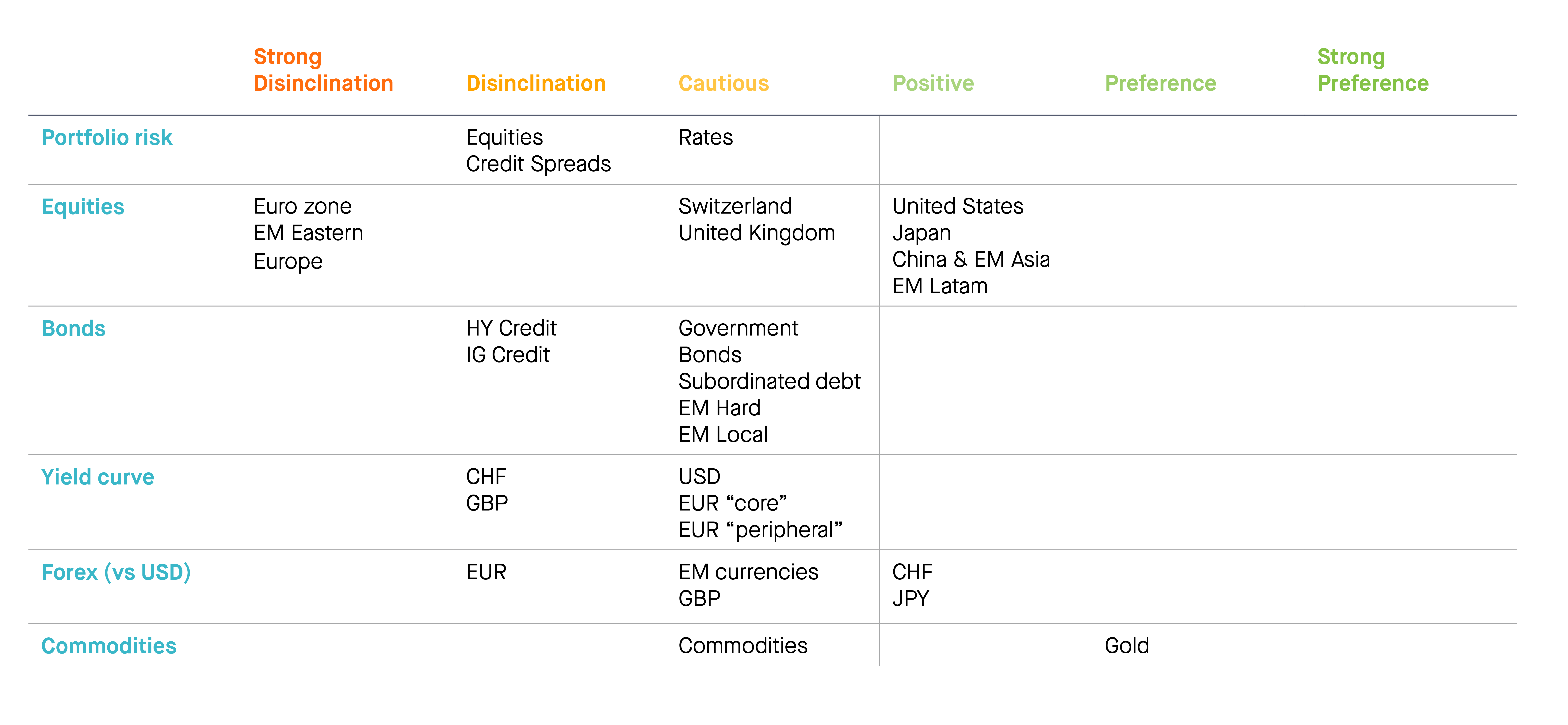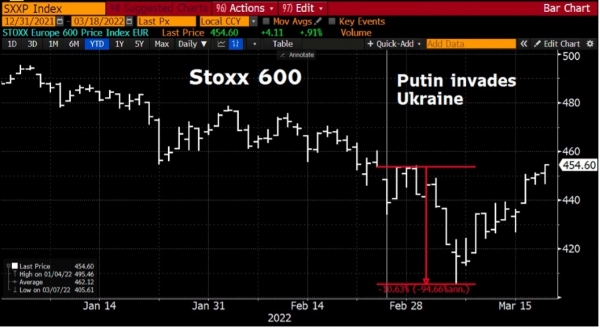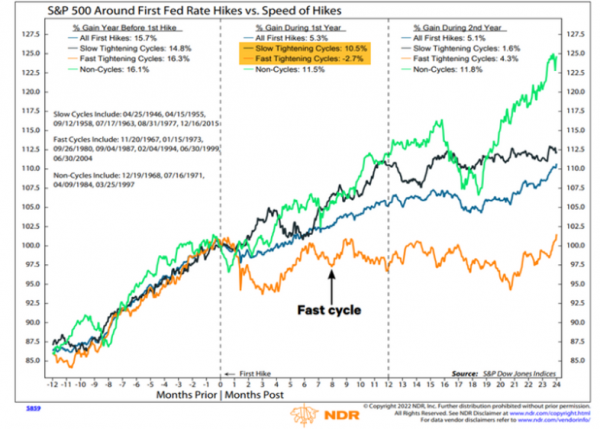Global stocks moved higher last week, reclaiming much of the ground lost over the past month. The Nasdaq 100 rose 8.4% for the week. European stocks had their biggest rally since November 2020 and are back to the levels pre-dating the invasion.

Q&A 1 — Equity markets soared last week. What were the main reasons?
While the war in Ukraine continues, investors’ sentiment was buoyed by the following developments:
- Falling oil prices: while its price remains above the level just prior to Russia’s invasion of Ukraine, the price of crude oil has fallen more than 15% since a recent high on March 8.
- News that Russia had avoided defaulting on its sovereign debt: Russia default risk (CDS) tumbled last week as JPMorgan has processed funds that were earmarked for interest payments due on dollar bonds issued by the Russian government and sent the money on to Citigroup.
- Odds of a negotiated deal between Russia and Ukraine are on the rise. Last Wednesday, both sides indicated that discussions had yielded some progress. Such an outcome would be a positive for risk assets and markets are starting to price this scenario;
- The outcome of the Fed’s meeting: as expected, the Fed raised interest rates by 25 basis points at its March meeting, the first hike since 2018. The FOMC is expecting to raise rates seven times in 2022, according to the median projection. A reduction of their balance sheet is also in the cards. In addition, they downgraded their forecast for economic growth, while upwardly revising inflation projections. Equity markets seemed satisfied with the Fed’s approach and rallied following the meeting while U.S. Treasury yields shifted higher. More on this in the next question.
- China’s announcement that it would take measures to support the economy and financial markets. China equity markets recovered sharply by the middle of the week after policymakers pledged economic support. It was the best week ever for China Internet stocks as investors start to hunt for bargains (e.g Alibaba).
- Short covering on high beta stocks: Non-profitable Tech stocks were the big winners of last week. An index of tech companies with no profits is up 18% this week. Some hedge funds with some short positions on these names were forced buyers last week.
We also note that the “great rotation” (money flowing out of fixed income into equity mutual funds) continues unabated. Bond mutual funds net redemptions since the start of the year now stand at minus $65 billion, which is more than any year since 2007. It is also a sharp reversal after last year’s record $400b inflows. Meanwhile, equity funds keep recording inflows with another $25 billion of inflows just last week.
Q&A 2 — The Fed finally started its rate hike cycle last week. Is it a positive or negative development for risk assets?
Central bankers are facing a very difficult situation to solve: inflation continues to move higher (in part due to supply disruptions due to the Russia-Ukraine war), global growth has been revised downward while businesses and investors face an uncertain outlook due to the ongoing war in Ukraine. In our opinion, the Fed needs to raise rates sharply until at least mid-term elections to curb inflation. The move is likely to slow down economic growth to some extent. Ideally, this should lead to a soft-landing scenario but there is also the risk of a recession in 2023/2024. At the time of our writing, the market is pricing in December 2022 Fed rate at 2% while 2 rate cuts in 2023 / 2024 are now anticipated by traders.
Based on history, a rate hike cycle is not necessarily a bad outcome for equity markets. However, the performance of the S&P 500 during such monetary policy tightening depends to some extent on the speed of rate hikes. As shown on the chart below, a quick cycle is not the best outcome for equity markets.
As we wrote in our latest FLASH NOTE (“Fed meeting: Pragmatic, Constructive, Flexible”), the US central bank appears more worried by the downside risks for growth coming from too high inflationary pressures. As such, if inflation remains stubbornly higher than expectations and economic growth holds at a firm level, the balance among Fed members could rapidly shift toward an even-faster pace of rate hikes than the one currently priced by the market.
But last week’s statement also allows for some moderation in case of a significant slowdown in economic growth in the months ahead.
The influence of commodities prices on inflation and thus FOMC rates expectations explains why equities and oil performance have started to diverge. Should oil prices stay at a high level for a sustainable period of time, the Fed would have to be a lot more aggressive and that certainly would not be a pleasant scenario for the stock market.
Q&A 3 — Is the correction over? Time to add risk assets to the portfolio?
As highlighted in our latest Asset Allocation Insights (“The Facts, the Knowns and the Unknowns”), we have been gradually reducing our exposure to equities and credit over the last few months based not only on fundamental & technical indicators but also on systematic risk balancing.
While staying invested, we chose to keep a cautious stance and wait for more visibility, on the geopolitical, economic and corporate earnings outlook.
From what we learned last week, we continue to believe that the macro perspective has deteriorated. While we do not anticipate “stagflation” at this stage, our “core” scenario for 2022 has been adjusted toward slower growth and higher inflation. Unlike previous market or macro shocks, central banks are not expected to provide decisive support to the market unless the crisis deepens significantly. Equity markets are getting cheaper but earnings forecasts have not been adjusted by consensus yet. On an aggregated basis, our fundamental indicators have turned negative on an aggregated basis, which lead us to be cautious with regards to our equity exposure. On the positive side, our market technical indicators have been improving recently mainly thanks to signals stemming from volume, volatility and trend. As such, we have very slightly increased our exposure to global equities compared to 10 days ago. Our favorite markets remain the US and Japan. From a style and sector perspective, we keep a mix of growth and value stocks.

Disclaimer
Le présent document a été publié par le Groupe Syz (ci-après dénommé «Syz»). Il n’est pas destiné à être distribué ou utilisé par des personnes physiques ou morales ressortissantes ou résidentes d’un Etat, d’un pays ou d’une juridiction dans lesquels les lois et réglementations en vigueur interdisent sa distribution, sa publication, son émission ou son utilisation. Il appartient aux utilisateurs de vérifier si la Loi les autorise à consulter les informations ci-incluses. Le présent document revêt un caractère purement informatif et ne doit pas être interprété comme une sollicitation ou une offre d’achat ou de vente d’instrument financier quel qu’il soit, ou comme un document contractuel. Les informations qu’il contient ne constituent pas un avis juridique, fiscal ou comptable et peuvent ne pas convenir à tous les investisseurs. Les valorisations de marché, les conditions et les calculs contenus dans le présent document sont des estimations et sont susceptibles de changer sans préavis. Les informations fournies sont réputées fiables. Toutefois, le Groupe Syz ne garantit pas l’exhaustivité ou l’exactitude de ces données. Les performances passées ne sont pas un indicateur des résultats futurs.


